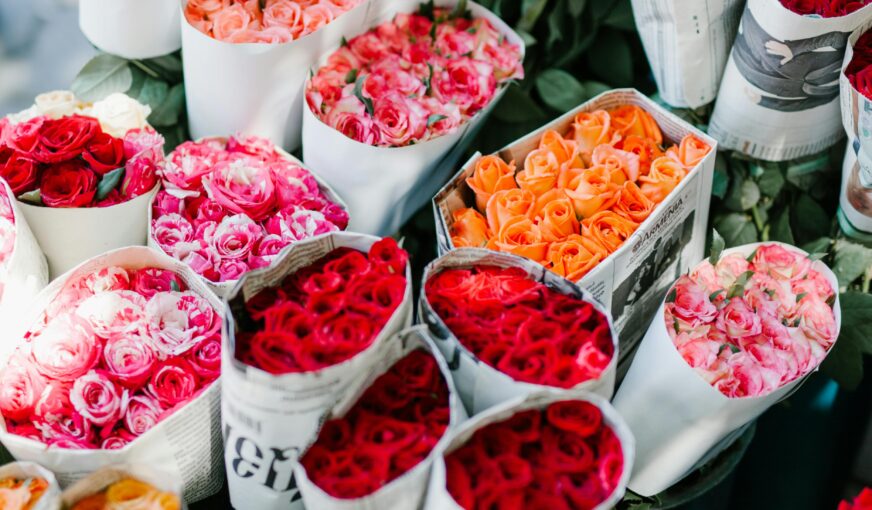
When it comes to creating beautiful flower arrangements, pairing the right blooms together
can make all the difference. However, flower pairing isn’t just about aesthetics. It involves
understanding how different flowers complement each other in color, shape, and
fragrance. With the right approach, you can transform any bouquet into a masterpiece. In
this Your Guide to Flower Pairing, we’ll explore the art of flowers and provide you
with expert tips for creating stunning floral arrangements.
Flower pairing is a crucial aspect of floral design. The right combination of flowers not only
enhances the visual appeal of your arrangement but also brings out the best in each
bloom. Understanding how different flowers work together is the first step toward crafting
a truly unique and eye-catching bouquet.
Whether you’re preparing a wedding bouquet or simply brightening up your living room,
choosing the right flower combinations can make all the difference.
Before diving into specifics, it’s essential to understand the basics of flower
composition. Flower pairing is all about balance. Some flowers may stand out on their
own, but when paired with complementary blooms, they can create a sense of harmony
and elegance.
When pairing, consider their color, texture, size, and shape. These elements play a
vital role in how flowers interact within an arrangement. For instance, larger flowers like
peonies or roses can be paired with smaller, delicate flowers like baby’s breath or daisies
to create contrast and depth.
Color is one of the most important factors to consider when flower pairing. Whether you’re
aiming for a bold, vibrant arrangement or a soft, pastel look, color harmony will set the
tone for your bouquet. Below are some popular colors to get you started.
Complementary Colors: Complementary colors are opposite each other on the color
wheel and create a striking contrast. Think of pairing red roses with green leaves or purple
and yellow blooms.
Analogous Colors: Analogous colors are next to each other on the color wheel. This creates
a softer, more serene arrangement. For example, try pairing pink tulips with peach roses
and lavender.
Monochromatic Pairing: Monochromatic arrangements focus on one color in varying
shades. For instance, a bouquet of white lilies, white roses, and white orchids creates a
sophisticated, cohesive look.
Texture plays a significant role in making flower arrangements visually appealing. When
pairing flowers, aim for a mix of smooth, spiky, and ruffled textures to create a dynamic
bouquet. Additionally, varying shapes add complexity and dimension to your arrangement.
Large and Small: Pairing large blooms like hydrangeas with smaller flowers like freesias
creates a beautiful contrast in both shape and size.
Round and Spiky: Round flowers like dahlias work well with spiky flowers like thistles or
delphiniums. The difference in shape creates a sense of movement and balance.
Seasonality is another critical factor to consider when pairing flowers. Not only does it
affect the availability of certain flowers, but it also helps create a more natural,
harmonious arrangement. Here’s how to pair flowers according to the season:
Spring: Opt for light and airy blooms like tulips, daffodils, and peonies. Pair them with
greenery like ferns or ivy for a fresh, organic look.
Summer: Bright and bold flowers like sunflowers, dahlias, and zinnias thrive in summer.
Pair these with soft, romantic blooms like lavender or roses for a balanced bouquet.
Fall: Autumn is the perfect time for warm, rich colors. Pair chrysanthemums, asters, and
marigolds with golden accents or dark foliage like eucalyptus for a cozy, fall-inspired
arrangement.
Winter: For winter, consider deep, rich hues like crimson or burgundy.
Flowers like amaryllis and poinsettias pair beautifully with pine branches, holly, or ivy to
create a festive, seasonal arrangement.
Certain occasions call for specific flower arrangements that evoke the right emotions and set the
tone. Here are some pairings perfect for different events:
Weddings: A classic wedding bouquet pairs white lilies with soft roses and touches of
greenery. For a bolder look, try a combination of deep red roses, peonies, and orchids.
Birthdays: For a cheerful birthday arrangement, combine bright yellow sunflowers with
pink gerbera daisies and purple asters. These colors create an uplifting, joyful bouquet.
Anniversaries: Celebrate an anniversary with a combination of timeless flowers like red
roses, white lilies, and delicate baby’s breath. This romantic pairing never goes out of style.
If you’re new to flower arranging, here are some simple tips to help you get started with
pairing flowers:
Stick to a Color Palette: Keep your color palette in mind to ensure the flowers work well
together. Limiting the number of colors can make the pairing process easier.
Consider Flower Heights: When arranging flowers, make sure the heights are balanced.
Taller flowers should be placed in the center, while smaller blooms fill in the surrounding
areas.
Incorporate Foliage: Foliage adds texture and greenery to your arrangement. Don’t forget to
pair flowers with complementary leaves or vines for extra flair.
Play with Symmetry: Experiment with symmetrical and asymmetrical arrangements. Both
styles can create stunning results, depending on your aesthetic preferences.
What flowers fit well together for a rustic look?
For a rustic feel, consider pairing sunflowers, lavender, and wildflowers like daisies or
poppies. These blooms give off a natural, countryside vibe perfect for outdoor weddings or
casual celebrations.
How do I mix flowers for a modern arrangement?
For a contemporary look, pair sleek, simple flowers like orchids or calla lilies with
minimalistic greenery such as eucalyptus or monstera leaves.
Can I mix different flower types in one bouquet?
Absolutely! Mixing different flower types can add interest and texture to your arrangement.
Just ensure that the colors, textures, and shapes complement each other.
Flower pairing is an art that requires an understanding of color, texture, shape, and
occasion. Whether you’re creating a floral centerpiece for a wedding or a simple bouquet
for your home, the right combination of blooms can make all the difference. With the tips
and ideas shared in this Your Guide to Flower Pairing, you can confidently create stunning
flower arrangements for any occasion.